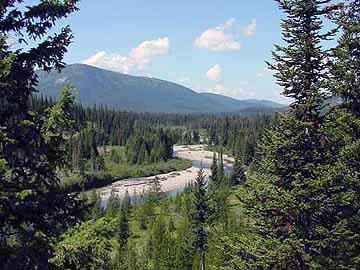A plan to develop coalbed methane reserves in British Columbia just north of Glacier National Park have been dropped. However, there still are plans to develop coal reserves in the region.
Montana's two U.S. senators, Max Baucus and John Tester, have been meeting with British Petroleum Canada officials over the coalbed methane plans. This past Thursday Sen. Baucus announced that BP was dropping the project.
The area where the energy resources are thought to lie is at the headwaters of the Flathead River, which runs south into Montana. Tucked into British Columbia's southeastern corner, just a bit north of Glacier Park and due west of Waterton Lakes National Park, the Canadian Flathead Valley is a 40-mile swath of sawtooth-tipped mountains and alluvial plains that cradle the headwaters of the Flathead River. That ruggedness, with its resident grizzly bears, wolves, elk, lynx, mountain goat, wolverine and pristine fisheries of bull trout and Westslope cutthroat trout, has prompted one biologist to tag the area as "the single most important basin for carnivores in the Rocky Mountains."
In commenting on BP's decision British Columbia officials told The Associated Press that "(T)he province recognizes the sensitivity of the Flathead Valley..."
Still a threat to the region's environment, though, is the proposal by Cline Mining Corp. to sink an open-pit coal mine into the area. Efforts to tap these resources could have devastating impacts on the Canadian Flathead Valley and those areas downstream in the United States, according to those who have looked into the matter.
"The environmental impacts associated with this massive industrial incursion into the Canadian Flathead would be significant by any measure," Joseph L. Sax and Robert B. Keiter wrote in analyzing the threats that confront Glacier in an article that recently appeared in the University of California's Ecology Law Quarterly. Mining projects of this magnitude will require an expansive infrastructure of new roads and pipelines that will have to be constructed on unstable mountainous terrain.
"Water quality degradation is also a major concern," they added. "The proposed Cline coal mine could dramatically increase sedimentation levels and toxic pollutants in North Fork tributary streams and destroy bull trout spawning grounds. Coalbed methane development, based on experience elsewhere, involves extracting massive amounts of alkaline wastewater that must be disposed of somewhere.
"Wildlife would also be put at risk. New roads and drilling rigs will mean habitat loss and fragmentation, increased poaching opportunities, and the severance of key migratory routes."
National Parks Conservation Association officials praised BP's decision and called on British Columbia officials to continue to work to protect the region's environment.
“Senator Baucus, Senator Tester, and Governor (Brian) Schweitzer are true champions for our national parks, and their tireless efforts to eliminate this threat to the integrity of Glacier Park have met with success,” said NPCA President Tom Kiernan. “They fully understand that Glacier National Park and surrounding wildlands are true international treasures that should not be comprised with industrial fossil fuel extraction.”
“We also compliment the government of British Columbia for their recognition that there are places too special and internationally significant for the type of activity that BP proposed,” Kiernan added. “We encourage Canadian officials to put in place long-term protections that ensure the splendor of Waterton-Glacier Park and the Canadian Flathead for future generations.”




Comments
Gas resources will soon come to an end. Instead of just throwing our money down our kitchen sinks we should better think of ways to replace methane with renewable energy sources.